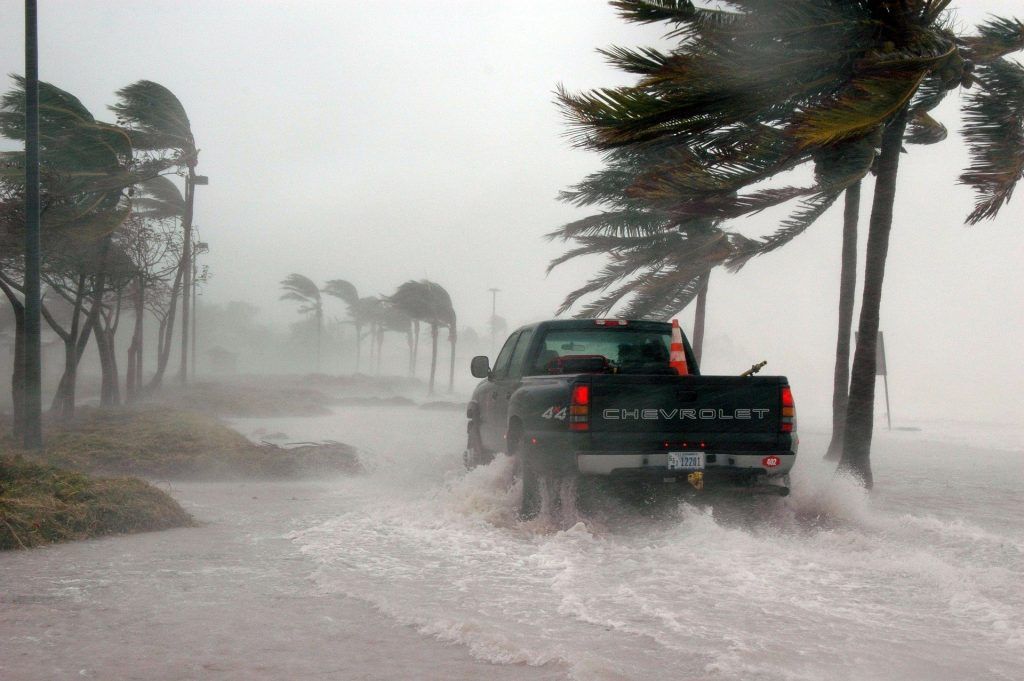Is FEMA footing the bill for others’ repeated climate-change mistakes?
By Alice C. Hill | April 8, 2020
 A pickup truck drives through high water during a hurricane in Key West, Florida. Image courtesy of David Marks/Pixabay
A pickup truck drives through high water during a hurricane in Key West, Florida. Image courtesy of David Marks/Pixabay
Americans like to think of themselves as self-reliant. Yet, when disaster strikes, the federal government provides the insurance policy for businesses and ordinary citizens alike. That’s true for the damage from a COVID-19 pandemic or from storm-driven flooding. History will tell whether that makes sense for a disaster on the scale of the current pandemic. But it certainly does not make fiscal sense for Congress to act as the primary insurer for the types of hazards the nation regularly experiences.
Thanks to Congress’ growing generosity in the wake of natural disasters, Americans have come to expect that the federal government will pick up the tab all the time—effectively providing, in the words of one FEMA administrator, a “no-limit, no-premium insurance policy for infrastructure and property.” The guarantee of a payout for natural disasters like flooding and wildfires creates a so-called “moral hazard” for those deciding where and how to build—in other words, communities and individuals have little or no incentive to invest in risk reduction measures because someone else (the US taxpayer) is footing the bill. With climate change fueling the frequency and intensity of natural disasters, the federal government must put an end to this moral hazard. It must insist that those making the decisions about where and how to build have their own money at risk— have “skin in the game.”
The federal government didn’t always pick up the tab for damage from natural disasters. But in the last seven decades, Congress has increasingly covered the bills. During the decade from 2005 to 2014, the federal government committed almost $280 billion for disaster assistance. Congress has spent over $3.6 trillion on disaster relief alone since 1964. With worsening climate impacts—more intense storms, bigger wildfires, deeper droughts, greater extremes of heat and precipitation, in addition to sea-level rise—these bills will only grow.
One way to shrink the ballooning invoice is to ensure that the decisions about where and how to build take into account the growing risks of climate change. According to a recent National Institute of Building Sciences study, every dollar spent on reducing risk before disaster strikes saves approximately $6 in damages. And when it comes to building in accordance with the latest building codes, the savings grow to $11 for every $1 invested.
The authority to decide where and how to build, however, rests almost exclusively with state and local governments, many of which have declined to impose risk-reduction measures. For example, only 32 percent of disaster-prone jurisdictions have adopted disaster-resistant building codes. That means that about two-thirds of jurisdictions do not yet require that buildings be built for today’s disasters, much less those that rising temperatures fuel.
The story with regard to land use is equally disturbing. Take California, for example.
Despite worsening wildfire risk, shortly after the deadly 2018 Paradise fire, Los Angeles County approved a 19,000-home development in an area already determined to be at high or very high risk of fire even before accounting for the effects of climate change. Across the nation, local governments also continue to approve new development in flood-prone areas.
The failure of state and local governments to insist on better building practices and land use decisions comes at a cost to federal coffers that will only increase with climate change. Indeed, since at least 2013, the Government Accountability Office has flagged the fiscal exposure to climate change as a high risk to the federal treasury.
Congress urgently needs to reverse course. An easy place to start is by insisting on the use of climate resilient building codes for structures built with federal funds, and by withholding federal support for new development in high-risk areas.
Estimates for the time it will take to develop climate-resilient building codes stretch as long as a decade. In light of the growing threats from climate change impacts, the nation cannot wait that long. It needs to jumpstart the creation of building standards for perils worsened by climate change. Fortunately, it has already done so in the case of flood. The Obama administration created a federal flood risk management standard designed to ensure that where federal tax dollars fund development in or near a floodplain, those buildings were elevated to account for future flood risk worsened by climate change. Unfortunately, 10 days before Hurricane Harvey poured more than four feet of rain on the Houston area, President Trump rescinded the standard. It’s time to bring it back and begin creating interim federal risk management standards for other damaging hazards from climate change.
To promote sound land use practices, Congress can learn from its experience with the Coastal Barrier Resources Act. In the 1980s, the federal government decided to withdraw support for new development in certain coastal areas at particularly high risk. Local communities could continue to develop, but they would receive no support from federal taxpayers. Researchers have recently forecasted that the federal government will save over $100 billion in the next 50 years because of that decision.
Insisting that local communities take more responsibility for reducing risk will save federal taxpayer money. It could also save lives. In the face of climate change, the federal government needs to help state and local communities make better decisions about where and how to build. Doing so will leave all of us better off and spare the federal Treasury even more expense as it opens the purse for the pandemic recovery.
Together, we make the world safer.
The Bulletin elevates expert voices above the noise. But as an independent nonprofit organization, our operations depend on the support of readers like you. Help us continue to deliver quality journalism that holds leaders accountable. Your support of our work at any level is important. In return, we promise our coverage will be understandable, influential, vigilant, solution-oriented, and fair-minded. Together we can make a difference.
Keywords: FEMA, climate change, climate crisis, flood insurance, flooding, global warming, hurricane, moral hazard, natural disasters, resiliency, sea level rise, wildfires
Topics: Analysis, Climate Change















